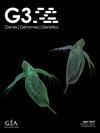更新的小鼠通用基因分型阵列生物信息学管道提高了实验室小鼠的基因质量控制水平
IF 2.1
3区 生物学
Q3 GENETICS & HEREDITY
引用次数: 0
摘要
MiniMUGA 基因分型阵列是实验室小鼠遗传质量控制和大多数实验室品系杂交样本基因分型的常用工具,尤其适用于复杂性较低的杂交。MiniMUGA 阵列生产版本的内容是固定的;但是,通过利用自 MiniMUGA 首次描述以来基因分型的数千个样本,有机会提高阵列的性能和相关报告的实用性。在此,我们报告了我们在更新和改进标记注释、增加经典近交系和亚系共识基因型的数量和可靠性以及增加用 MiniMUGA 可靠检测的构建质粒数量等方面所做的努力。此外,我们还对信息学管道进行了重要修改,以识别和量化特定遗传背景对给定样本组成的贡献,去除任意阈值,将 Y 染色体和线粒体基因组纳入表意图,并根据诊断等位基因改进对商业化亚品系存在的稳健检测。最后,我们更新了报告的布局,以简化分析的解释和完整性,并增加了一个以表格形式总结表意图的部分。这些变化将引起小鼠研究界的普遍兴趣,并将有助于我们实现提高基于小鼠的生物医学研究的严谨性和可重复性的目标。本文章由计算机程序翻译,如有差异,请以英文原文为准。
The updated mouse universal genotyping array bioinformatic pipeline improves genetic QC in laboratory mice
The MiniMUGA genotyping array is a popular tool for genetic quality control of laboratory mice and genotyping samples from most experimental crosses involving laboratory strains, particularly for reduced complexity crosses. The content of the production version of the MiniMUGA array is fixed; however, there is the opportunity to improve the array's performance and the associated report's usefulness by leveraging thousands of samples genotyped since the initial description of MiniMUGA. Here, we report our efforts to update and improve marker annotation, increase the number and the reliability of the consensus genotypes for classical inbred strains and substrains, and increase the number of constructs reliably detected with MiniMUGA. In addition, we have implemented key changes in the informatics pipeline to identify and quantify the contribution of specific genetic backgrounds to the makeup of a given sample, remove arbitrary thresholds, include the Y Chromosome and mitochondrial genome in the ideogram, and improve robust detection of the presence of commercially available substrains based on diagnostic alleles. Finally, we have updated the layout of the report to simplify the interpretation and completeness of the analysis and added a section summarizing the ideogram in table format. These changes will be of general interest to the mouse research community and will be instrumental in our goal of improving the rigor and reproducibility of mouse-based biomedical research.
求助全文
通过发布文献求助,成功后即可免费获取论文全文。
去求助
来源期刊

G3: Genes|Genomes|Genetics
GENETICS & HEREDITY-
CiteScore
5.10
自引率
3.80%
发文量
305
审稿时长
3-8 weeks
期刊介绍:
G3: Genes, Genomes, Genetics provides a forum for the publication of high‐quality foundational research, particularly research that generates useful genetic and genomic information such as genome maps, single gene studies, genome‐wide association and QTL studies, as well as genome reports, mutant screens, and advances in methods and technology. The Editorial Board of G3 believes that rapid dissemination of these data is the necessary foundation for analysis that leads to mechanistic insights.
G3, published by the Genetics Society of America, meets the critical and growing need of the genetics community for rapid review and publication of important results in all areas of genetics. G3 offers the opportunity to publish the puzzling finding or to present unpublished results that may not have been submitted for review and publication due to a perceived lack of a potential high-impact finding. G3 has earned the DOAJ Seal, which is a mark of certification for open access journals, awarded by DOAJ to journals that achieve a high level of openness, adhere to Best Practice and high publishing standards.
 求助内容:
求助内容: 应助结果提醒方式:
应助结果提醒方式:


